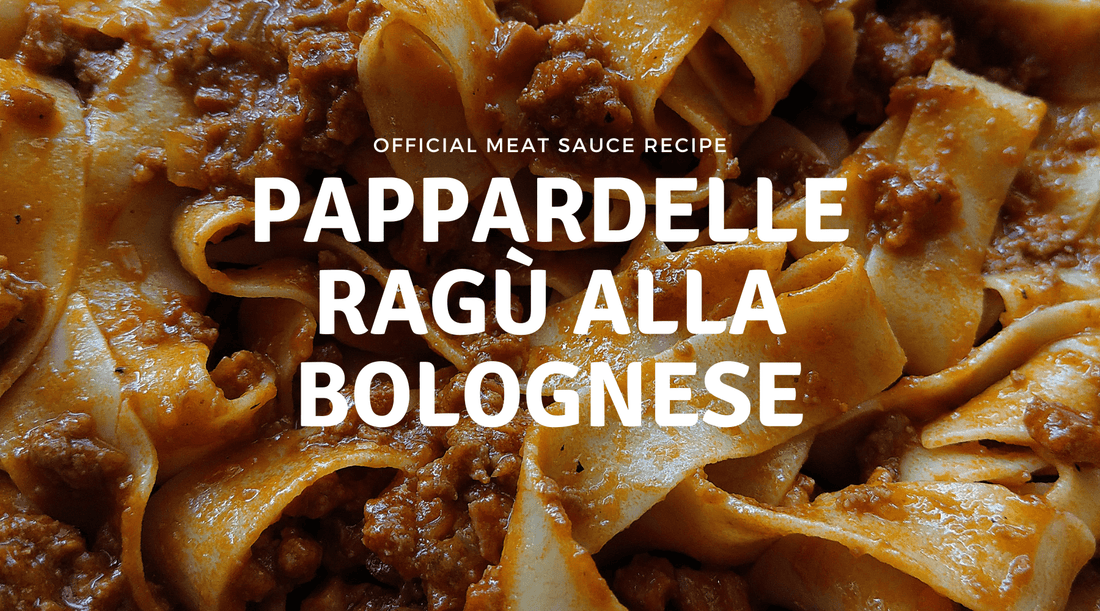Welcome to the true Italian meat-based sauce Ragù alla Bolognese, a quintessential dish from Bologna, in Emilia-Romagna. An official updated version based on the original recipe registered with Chamber of Commerce of Bologna Academia Italiana della Cucina in 1982. This meaty sauce, both rich and creamy, unfolds through the slow-cooking process, embracing the simplicity of salt and pepper by omitting all other aromatics. The slow-simmered sauce, carefully developed over 3 hours boasts authenticity, ensuring a satisfying depth of flavour, and guarantees an exquisite richness in both texture and taste that includes the ever-so-classic Soffritto. This recipe is paired perfectly with fresh egg Pappardelle and caters to 4-6 main servings. Take a visual tour of this dish and many others through my collection of photos on my Instagram.
Ragù ingredients
- 150g pancetta
- 3 tbsp olive oil
- 60g; 1 onion, finely chopped
- 60g; 1 carrot, finely chopped
- 60g; 1 rib of celery, finely chopped
- 400g quality minced beef
- 150ml (1 glass) dry white wine
- 1 tablespoon double-concentrated tomato paste
- 200g tomato puree
- Beef broth, as needed
- 150ml (1 glass) whole milk
- Salt and pepper to taste
- Pasta water (reserved from the pasta)
Other ingredients
- 300g egg Pappardelle
- 30g freshly grated Parmigiano-Reggiano
Instructions
1. Kick off by frying the pancetta in a heavy-based pot around 24-26cm in diameter. Once cooked, take it out and set it aside.
2. Next, we go in with the soffritto: slowly simmer onion, carrot, and celery in a generous amount of evoo for 15 minutes, ensuring a satisfying depth of flavour.
3. Add ground meat, breaking it up with the back of a wooden spoon while cooking, then reintroduce the pancetta, now allowing all the ingredients to meld seamlessly for 10 minutes.
4. Deglaze the pan with white wine, stirring at medium heat for approximately 3 minutes or until the wine evaporates.
5. Incorporate the tomato paste and puree, bring to a boil, then add the broth, reducing to the lowest heat setting after it starts to bubble.
6. Cover and simmer for a total of 3 hours, stirring every ½ hour. Add a dash of broth as needed, you shouldn’t need too much as you want to maintain a thick consistency.
7. Midway through, remove the lid and introduce milk, then bring to a boil while stirring through, followed by a return to a simmer.
8. Cook your pasta according to package directions. Reserve some pasta water.
9. In the final 10 minutes, slightly raise the heat to achieve a slow boil, stirring often.
10. Taste for seasoning, adjusting with salt and pepper as necessary and adding a few tablespoons of pasta water until the desired consistency is achieved. Click here to shop Fantasea-salt, the best all natural gourmet booster for Italian cuisine!
11. Add the cooked Pappardelle. The sauce should now envelop and dress the ribbons.
12. Allow diners to serve themselves by placing on the table the Parmigiano-Reggiano, also from the Emilia-Romagna region.
This is the renewed recipe reflecting a more modern approach by incorporating tomato puree, which allows more of a ‘sauce’, and the option of choosing white or red wine and even skipping the milk! Everyone has their take on this classic recipe, and I'm no exception. While this is the authentic recipe, feel free to add or remove ingredients as you please, tailoring it to suit your family's taste preferences, just as I usually do. Keep in mind that deviating from this recipe will no longer result in the traditional Ragù Bolognese. Once you've mastered the original, you'll gain a better understanding and be well-equipped to create your next masterpiece. Consider choosing this ragù recipe for your next lasagna and enjoy the ease of another ‘one-pot’ classic!
Tradition, Techniques, and Storage
- For mince, use 20% fat 80% beef. The fat contributes to the overall profile.
- Tomato paste adds a depth of body to the sauce, use a double amount of regular if concentrate isn't available.
- The addition of milk not only makes the meat tender but imparts an orange hue to the sauce, distinguishing it from the red versions many are accustomed to. It also aids in balancing the acidity of the tomatoes.
- Chop vegetables by hand; avoid using a food processor as the blades can generate heat and impact the flavours.
- Traditionally, a wooden spoon is always used to stir, and the sauce is cooked in a terracotta pot.
- To store, allow the meat sauce to cool completely before transferring it into an airtight container. It can be refrigerated for up to four days or frozen for two or so months.
- Adjust your quantities as needed. Serving ratio for 1 person is around 85g dry pasta to 1/2 cup (125 ml) bolognese sauce.

